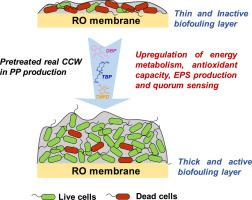当前位置:
X-MOL 学术
›
Water Res.
›
论文详情
Our official English website, www.x-mol.net, welcomes your feedback! (Note: you will need to create a separate account there.)
Biofouling behaviors of reverse osmosis membrane in the presence of trace plasticizer for circulating cooling water treatment: Characteristics and mechanisms
Water Research ( IF 11.4 ) Pub Date : 2024-06-12 , DOI: 10.1016/j.watres.2024.121937 Yi Luo 1 , Riji Qiu 1 , Xingran Zhang 1 , Fang Li 1
Water Research ( IF 11.4 ) Pub Date : 2024-06-12 , DOI: 10.1016/j.watres.2024.121937 Yi Luo 1 , Riji Qiu 1 , Xingran Zhang 1 , Fang Li 1
Affiliation

|
Reverse osmosis (RO) system has been increasingly applied for circulating cooling water (CCW) reclamation. Plasticizers, which may be dissolved into CCW system in plastic manufacturing industry, cannot be completely removed by the pretreatment prior to RO system, possibly leading to severe membrane biofouling. Deciphering the characteristics and mechanisms of RO membrane biofouling in the presence of trace plasticizers are of paramount importance to the development of effective fouling control strategies. Herein, we demonstrate that exposure to a low concentration (1 − 10 μg/L) of three typical plasticizers (Dibutyl phthalate (DBP), Tributyl phosphate (TBP) and 2,2,4-Trimethylpentane-1,3-diol (TMPD)) detected in pretreated real CCW promoted biofilm formation. DBP, TBP and TMPD showed the highest stimulation at 5 or 10 μg/L with biomass increasing by 55.7 ± 8.2 %, 35.9 ± 9.5 % and 32.2 ± 14.7 % respectively, relative to the unexposed control. Accordingly, the bacteria upon exposure to trace plasticizers showed enhanced adenosine triphosphate (ATP) activity, stimulated extracellular polymeric substances (EPS) excretion and suppressed intracellular reactive oxygen species (ROS) induction, causing by upregulation of related genes. Long-term study further showed that the RO membranes flowing by the pretreated real CCW in a polypropylene plant exhibited a severer biofouling behavior than exposed control, and DBP and TBP parts played a key role in stimulation effects on bacterial proliferation. Overall, we demonstrate that RO membrane exposure to trace plasticizers in pretreated CCW can upregulate molecular processes and physiologic responses that accelerate membrane biofouling, which provides important implications for biofouling control strategies in membrane-based CCW treatment systems.
中文翻译:

微量增塑剂存在下循环冷却水处理反渗透膜的生物污染行为:特征与机制
反渗透(RO)系统越来越多地应用于循环冷却水(CCW)回收。塑料制造行业中可能溶解到CCW系统中的增塑剂,在RO系统之前的预处理中无法完全去除,可能导致严重的膜生物污染。破译微量增塑剂存在下 RO 膜生物污垢的特征和机制对于制定有效的污垢控制策略至关重要。在此,我们证明暴露于低浓度(1-10μg/L)的三种典型增塑剂(邻苯二甲酸二丁酯(DBP)、磷酸三丁酯(TBP)和2,2,4-三甲基戊烷-1,3-二醇(TMPD) )) 在预处理的真实 CCW 中检测到促进生物膜形成。 DBP、TBP 和 TMPD 在 5 或 10 μg/L 时表现出最高刺激,相对于未暴露的对照,生物量分别增加了 55.7 ± 8.2 %、35.9 ± 9.5 % 和 32.2 ± 14.7 %。因此,接触微量增塑剂后,细菌表现出三磷酸腺苷(ATP)活性增强,刺激细胞外聚合物(EPS)排泄并抑制细胞内活性氧(ROS)诱导,这是由相关基因上调引起的。长期研究进一步表明,聚丙烯装置中经预处理的真实CCW流过的RO膜表现出比暴露对照更严重的生物污染行为,并且DBP和TBP部分对细菌增殖的刺激作用发挥了关键作用。 总体而言,我们证明,在预处理的 CCW 中,RO 膜暴露于微量增塑剂可以上调加速膜生物污垢的分子过程和生理反应,这为基于膜的 CCW 处理系统中的生物污垢控制策略提供了重要意义。
更新日期:2024-06-12
中文翻译:

微量增塑剂存在下循环冷却水处理反渗透膜的生物污染行为:特征与机制
反渗透(RO)系统越来越多地应用于循环冷却水(CCW)回收。塑料制造行业中可能溶解到CCW系统中的增塑剂,在RO系统之前的预处理中无法完全去除,可能导致严重的膜生物污染。破译微量增塑剂存在下 RO 膜生物污垢的特征和机制对于制定有效的污垢控制策略至关重要。在此,我们证明暴露于低浓度(1-10μg/L)的三种典型增塑剂(邻苯二甲酸二丁酯(DBP)、磷酸三丁酯(TBP)和2,2,4-三甲基戊烷-1,3-二醇(TMPD) )) 在预处理的真实 CCW 中检测到促进生物膜形成。 DBP、TBP 和 TMPD 在 5 或 10 μg/L 时表现出最高刺激,相对于未暴露的对照,生物量分别增加了 55.7 ± 8.2 %、35.9 ± 9.5 % 和 32.2 ± 14.7 %。因此,接触微量增塑剂后,细菌表现出三磷酸腺苷(ATP)活性增强,刺激细胞外聚合物(EPS)排泄并抑制细胞内活性氧(ROS)诱导,这是由相关基因上调引起的。长期研究进一步表明,聚丙烯装置中经预处理的真实CCW流过的RO膜表现出比暴露对照更严重的生物污染行为,并且DBP和TBP部分对细菌增殖的刺激作用发挥了关键作用。 总体而言,我们证明,在预处理的 CCW 中,RO 膜暴露于微量增塑剂可以上调加速膜生物污垢的分子过程和生理反应,这为基于膜的 CCW 处理系统中的生物污垢控制策略提供了重要意义。
















































 京公网安备 11010802027423号
京公网安备 11010802027423号